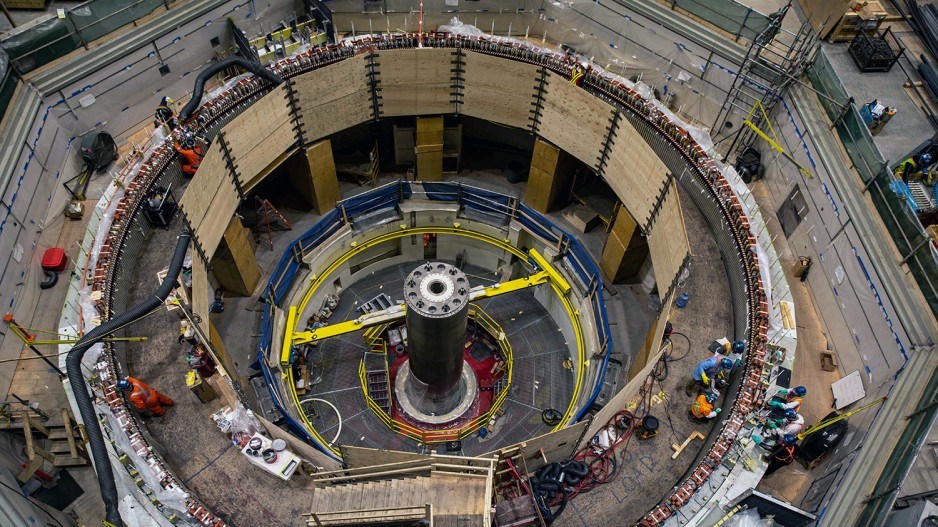For the last three or four years, the construction of four major energy projects collectively worth more than $80 billion has buoyed B.C.’s economy with tens of thousands of construction jobs and billions in procurement spending.
The Site C dam ($16 billion) near Fort St. John, the Coastal Gaslink natural gas pipeline ($14.5 billion), the Trans Mountain pipeline expansion ($30.9 billion) and LNG Canada project in Kitimat ($24 billion for B.C., $40 billion total) employed an estimated 19,000 to 20,000 workers last year.
In a recent economic forecast, Deloitte predicted B.C. will be harder hit than some other provinces by a recession this year, partly due to falling employment in non-residential construction, as work begins to wind down on LNG Canada and the Coastal GasLink and Trans Mountain pipelines.
But project delays due to the COVID-19 pandemic, natural disasters and labour shortages have meant that some of the work that was supposed to have been completed last year has been pushed into 2023, meaning there will still be plenty of construction work going on in B.C. this year as the province’s mega-projects enter the home stretch.
“COVID threw everything into chaos,” said BuildForce executive director Bill Ferreira. “So a lot of the work that was stacking up for 2021 has been pushed into 2023.”
The LNG Canada project Kitimat is about 85 per cent complete. It employs a workforce that can fluctuate, but peaks out at around 5,800.
“We expect to reach peak construction workforce at the Kitimat site in mid-to-late 2023,” an LNG Canada spokesperson told BIV.
Trans Mountain Corp., which last year employed an estimated 13,600 workers in B.C. and Alberta, said it expects to employ 10,500 to 11,000 workers in 2023 on its pipeline-twinning project.
In a project update in March, the company said the Trans Mountain expansion (TMX) project is 80 per cent complete, expected to finish by the end of this year and to be in service in the first quarter of 2024. A recent economic analysis by EY estimated the total spend on the pipeline expansion from 2018 to 2023 to be $26 billion, with $11 billion of that on wages.
TC Energy Corp. (TSX:TRP) said the Coastal GasLink (CGL) pipeline, which will feed the LNG Canada project in Kitimat with natural gas, is 85 per cent complete. Currently, there are about 5,000 workers employed on the project. Those numbers will drop for spring breakup before ramping back up.
“This summer – May, June and July – that will ramp up again significantly,” said Kiel Giddens, public affairs project director for TC Energy. “We are anticipating reaching over 6,000 people again this construction season to complete the project by the end of the year. So, it is still a significant construction year for us.”
Labour challenges have added significantly to the cost of both the CGL and TMX projects, which competed with each other for labour.
“It ended up being a perfect storm of a tight labour market, with not only Coastal GasLink, but of course LNG Canada, Site C and – more importantly for us – Trans Mountain happening at the same time,” Giddens said. “CGL was competing directly with TMX for labour, and they had significantly more people on their project in 2022 than we did – about 10,000. It just all kind of happened at the same time. It’s not something that was ever envisioned.”
In early 2024, CGL workers will start laying down their tools, and the workforce will contract to below 1,000 workers, many of whom will be focused on post-construction remediation work.
As for Site C dam, the project’s workforce peaked at 5,554 workers in October 2022. The project is now 75 per cent complete.
“As major project milestones are completed in the year ahead, we expect to see total employment on the project start to trend downward late this year,” BC Hydro spokesperson Greg Alexis said.
The project’s earth-fill dam is 90 per cent complete, as is work to realign Highway 29. Two new 500-kilovolt, 75-kilometre transmission lines and a new substation are complete. The dam project will mark a major milestone this year when the reservoir that was created will start to be filled. But it will still take two and a half years before the dam starts producing electricity in the fall of 2025.
As these four big energy projects all cross the finish line between 2024 and 2025, a big drawdown in the construction workforce is expected. But there are other liquefied natural gas (LNG) projects now in the queue, albeit smaller ones – Woodfibre LNG in Squamish and Cedar LNG in Kitimat – that may keep some workers employed in B.C. And should LNG Canada’s partners decide to pull the trigger and sanction a Phase 2 expansion – which would double production capacity – it would mean thousands of workers would still be needed for a few more years in Kitimat.
There are also several major public works projects underway in B.C., including the Broadway subway extension and Pattullo Bridge replacement. Construction of the new Surrey-Langley SkyTrain project is expected to begin in 2024.
“In terms of the overall employment, we’re going to see a bit of a step-down, but not a significant step-down,” Ferreira said. “After 2024, we start to see investment levels rising again.”
According to B.C.’s Major Projects Inventory, there were $389 billion worth of major projects either proposed, under construction, completed or on hold as of the third quarter of 2022, and $137 billion worth of construction actually underway. (Major projects are defined as anything over $15 million.)
Of the $389 billion worth of major projects proposed or underway, the oil and gas sector, which includes LNG, accounted for 32 per cent.



